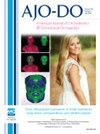不同初始后倾角在透明矫正器闭合拔牙间隙时的生物力学效应:有限元分析。
IF 3
2区 医学
Q1 DENTISTRY, ORAL SURGERY & MEDICINE
American Journal of Orthodontics and Dentofacial Orthopedics
Pub Date : 2025-05-12
DOI:10.1016/j.ajodo.2025.04.013
引用次数: 0
摘要
简介:本研究旨在评估使用透明矫正器治疗后牙关闭拔牙间隙时不同初始中远端倾斜度的生物力学影响。方法:建立三种不同的有限元模型,分别代表不同的初始后牙近端倾斜:模型1为近端倾斜15°,模型2为后牙直立,模型3为远端倾斜10°。共构建了12个具有不同后部防倾设计(0°,1°,2°和3°)的大规模回缩对准器模型来模拟空间关闭。结果:从模型1到模型3:矢状面,后牙增加了近中牙冠的运动,但减少了远端牙根的运动;在垂直方向上,后牙减少冠侵入,但增强牙根侵入;后旋中心向远端和尖端移位。水平方向上,模型3显示所有模型中后牙的中舌旋转最大。对于前牙,模型1表现出最多的切牙后缩和舌尖,而模型3表现出最少的切牙后缩和舌尖。此外,渐进式后牙防倾设计逐渐减少了后牙的中端倾和前牙的舌端倾。结论:不同的后牙近远端倾斜度在空间闭合过程中具有不同的三维生物力学效应。在使用矫正器关闭拔牙间隙时,应仔细考虑后牙的近远端角度。本文章由计算机程序翻译,如有差异,请以英文原文为准。

Biomechanical effects of different initial posterior inclinations during extraction space closure with clear aligners: A finite element analysis
Introduction
This study aimed to evaluate the biomechanical effects of different initial mesiodistal inclinations of posterior teeth during extraction space closure using clear aligner treatment.
Methods
Three different finite element models were developed for first premolar extractions, each representing different initial mesiodistal inclinations of the posterior teeth: model 1 with 15° mesial inclination, model 2 with upright posterior teeth, and model 3 with 10° distal inclination. A total of 12 en-masse retraction aligner models with varying posterior antitipping designs (0°, 1°, 2°, and 3°) were constructed to simulate space closure.
Results
From models 1 to 3: Sagittally, posterior teeth increased mesial crown movement but decreased distal root movement; vertically, posterior teeth reduced crown intrusion but enhanced root intrusion; the posterior rotation center shifted distally and apically. Horizontally, model 3 indicated the greatest mesiolingual rotation of posterior teeth across all models. For anterior teeth, model 1 exhibited the most incisor retraction and lingual tipping, whereas model 3 displayed the least incisor retraction and lingual tipping. In addition, the progressive posterior antitipping design gradually diminished both the mesial tipping of posterior teeth and the lingual tipping of anterior teeth.
Conclusions
Different mesiodistal inclinations of posterior teeth had various biomechanical effects in 3 dimensions during space closure. Careful consideration should be given to the mesiodistal angulation of posterior teeth during extraction space closure with aligners.
求助全文
通过发布文献求助,成功后即可免费获取论文全文。
去求助
来源期刊
CiteScore
4.80
自引率
13.30%
发文量
432
审稿时长
66 days
期刊介绍:
Published for more than 100 years, the American Journal of Orthodontics and Dentofacial Orthopedics remains the leading orthodontic resource. It is the official publication of the American Association of Orthodontists, its constituent societies, the American Board of Orthodontics, and the College of Diplomates of the American Board of Orthodontics. Each month its readers have access to original peer-reviewed articles that examine all phases of orthodontic treatment. Illustrated throughout, the publication includes tables, color photographs, and statistical data. Coverage includes successful diagnostic procedures, imaging techniques, bracket and archwire materials, extraction and impaction concerns, orthognathic surgery, TMJ disorders, removable appliances, and adult therapy.

 求助内容:
求助内容: 应助结果提醒方式:
应助结果提醒方式:


